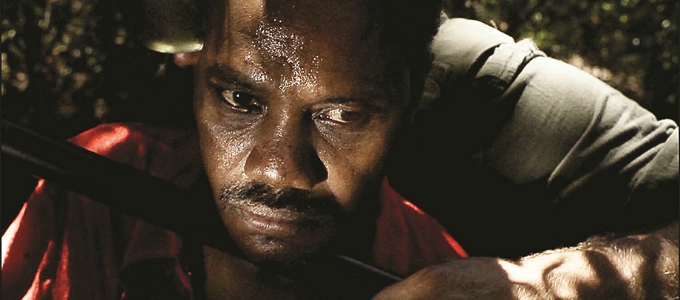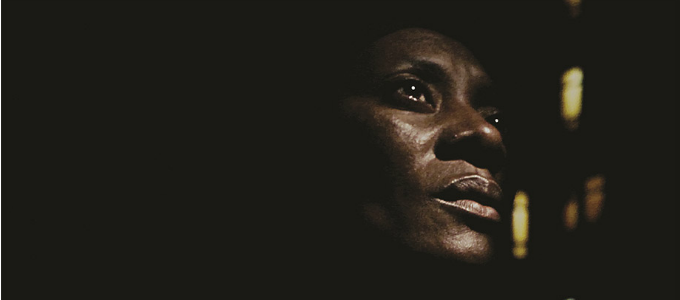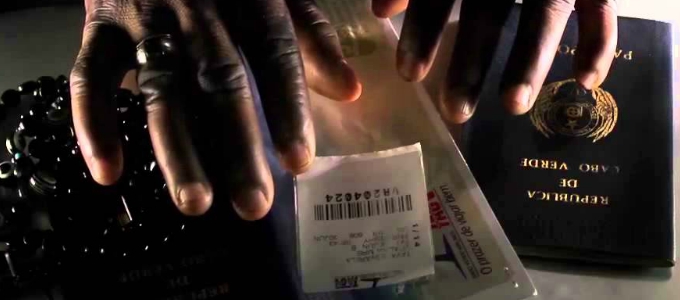 A series of shabby, candid stills preface CAVALO DINHEIRO, the fourth friend to Costa’s Fontainhas Trilogy. Photos of the dispossessed, the oppressed: like Willy Loman captured by Willy Ronis. It’s not long before we meet an avatar familiar to the fanboys: Costa’s chum Ventura, a venerated icon for Costa’s critical courtiers. Again the crumbling Cape Verdean immigrant appears as a hyperreal version of himself, drawing on personal memories augmented by drifting phrase and fable from the mind of his director.
A series of shabby, candid stills preface CAVALO DINHEIRO, the fourth friend to Costa’s Fontainhas Trilogy. Photos of the dispossessed, the oppressed: like Willy Loman captured by Willy Ronis. It’s not long before we meet an avatar familiar to the fanboys: Costa’s chum Ventura, a venerated icon for Costa’s critical courtiers. Again the crumbling Cape Verdean immigrant appears as a hyperreal version of himself, drawing on personal memories augmented by drifting phrase and fable from the mind of his director.
Ventura lost his wife in Costa’s earlier film, COLOSSAL YOUTH (2006) and here we find him penniless and perishing, apparently in the hands of the men in white coats. Ventura shuffles through the shadows, giving voice to his inner monologue. Costa encourages his old friend to purge, to let his mind course through ancient channels of reminiscence, to let his thoughts swell and overflow the memory banks. CAVALO DINHEIRO might be considered a kissing cousin to the films in Bresson’s “prison cycle”, and yet there is an undercurrent of rage against the dying of the light which more closely approaches the vigour of Bresson’s more atheistic work such as LE DIABLE, PROBABLEMENT (1977). O SANGUE (1989) was a scrapbook of its young maker’s cinematic heroes, such as Lang, Wiene, Murnau and Ray, and for all its maturity and originality, CAVALO DINHEIRO gives guileless mongrel nods to diverse influences; characters are presented through a prism of art history which glances from Caravaggio to Val Lewton. The austerity of the opening scenes smoothly segues into a mischievous halfway interlude, in which a Nan Goldin style montage of portraits of ex-Fontainhas residents is accompanied by Os Tubarões’ Alto Cutelo – a song of drought, loss, hardship and oppression. It’s a quirky touch reminiscent of a Tarantino film, and indeed Costa embraces the rogue spirit which is embodied in the brutish, aspirational English translation of this film’s title: HORSE MONEY.

Ventura meets a woman named Vitalina, and their exchange is conducted in Costa’s self-styled “Baudelairean night” – sparsely lit by pick-up-sticks of light and, in a different way, by Vitalina’s own inner radiance. We can barely see the pair – they may as well be speaking in the belly of a bathysphere. Vitalina has returned to this Lisbonian limbo to bury her husband. In our 2013 interview with Costa, he said of the cemetery scene in O SANGUE: “…this scene of a girl and a boy, lovers, burying a body… I thought this could be the ultimate romantic scene, at least for me! The best love scene for me is when the lovers bury someone. At that moment they are really in love”. Vitalina brings a strange tenderness to the film, but her painful preoccupation with birth and death certificates – the bureaucratic burden of the immigrant – recalls the words from the earlier scene in the hospital room, when Ventura was warned, “Don’t forget your passport. One never knows in a situation like this…”. These scenes exhibit a compelling post-Ionescan preoccupation with the fragility of identity. When Ventura stabbed a man during the revolution, did he condemn himself to bleed to death? His picking at the scab of this particular memory, along with portentous lines such as “We’ll keep on falling from the third floor”, suggest a Promethean purgatory. Ventura is in the dock, and his very existence is being placed under final judgement.
The stabbing isn’t something we can see for ourselves – Costa maintains a perpetual immediacy which forbids flashbacks. Instead, Ventura’s past possesses him – when his thoughts turn to the revolution in 1974, he puts on polyester flares and returns to the brink of Portugal’s independence, speaking as his 19 year old self. And not often since the mid-70s have we seen such economy and vitality in storytelling – like Peter Benchley’s Indianapolis monologue in JAWS (1975), John Waters’ execution speech in FEMALE TROUBLE (1974) or Woody Allen’s final thoughts in LOVE AND DEATH (1975), Costa’s presentation of each monologue is as simple and as powerful as it needs to be. He brings a bare-bones approach to cinematography as well, eschewing the depersonalising effect of artificial light. In an early scene, when Ventura rests in a hospital room, surrounded by friends and family, the sun strains through a featureless window, bathing the scene in light as frigid and pale as aspic. Costa is working with a Panasonic AG-DVX100 here, and yet his spiritual roots are in the traditional cinematic craft, such as Rohmer and Rouch. This particular camera is notoriously difficult to light, and yet cinematographer Leonardo Simoes uses it to conjure exquisite sonnets of light and colour from the shadows; like a virtuoso springing sweet music from a rusty saw.

Costa abhors cliché, and although he has an appreciative penchant for classic horror, this cinematic exorcism isn’t just a clumsy, artless mille-feuille of wrinkled skin, asylum walls, peeling paint and mouldy mortar. Costa is soft for Chaplin, hard for Ford. If OSSOS (1997) has the tenderness of the former, CAVALO DINHEIRO has the steady discipline of the latter: John Ford’s camera gives equal status to a man, a mountain, an animal or a prop. The Lisbon slum which spawned the Fontainhas tetralogy has been demolished, but in Ventura it finds its personification. Costa’s films are often crudely described as “dreamlike”, and yet his “feel the fear” approach is grounded in realism. The susurrations and paracusia of CAVALO DINHEIRO suggest dementia, or even death-bed delirium. Costa’s camera lingers on a face, an artefact, a quirk of architecture with a primacy which owes little to the restless dilettante gaze and omnivorous appetite of the dreamer. We are wandering not through a Slumberland slum but a dilapidated memory palace. Costa baits us with images and scripts which are meditative and immersive, flirting with archetype but defying hermeneutic enquiry. CAVALO DINHEIRO has a transcendental primacy which sets a landmark far from the psychological realism of IN VANDA’S ROOM (2000).
Narratively the film is impossible to summarise – one might as well ask a disaffected young scholar what they did at school today. They learned everything – they remember nothing. This is not a film to which you may yield; it is, though, a film which may submit to you. The acoustic trickery, capricious images and panoply of recollection create a reflective mise en abyme which transcends time and space, and even breaks the fourth wall: the film itself is a picturehouse, to be explored through a screen within a picturehouse. CAVALO DINHEIRO is both a treatment of and a demonstration of the achronological incontinence of memory. And after you’ve joined Ventura on his polyphonic spree up a lift shaft, you’ll never look at a living statue the same way again.
HORSE MONEY screens on 7th September at 20.00 at the Arts Picturehouse, and at selected cinemas across the UK from September 18th.
httpvh://youtu.be/2dbx4oIkP2E

